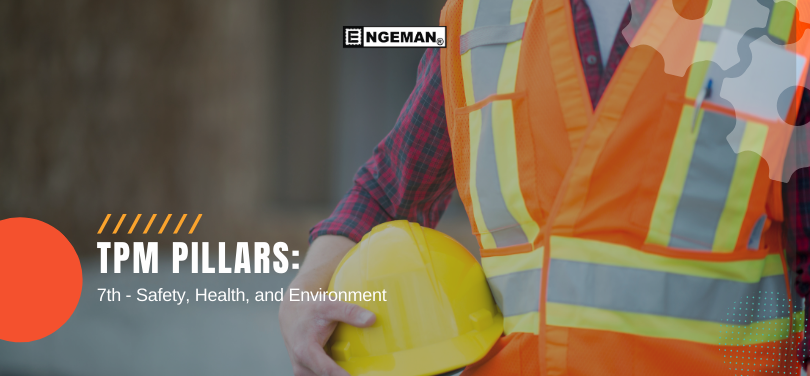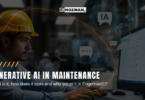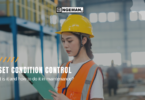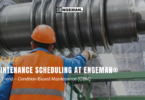Each Total Productive Maintenance Pillar is used by your company to achieve maximum productivity and reliability through zero failures and breaks. There are more technical pillars, which will deal more specifically with machine operation. Others are supportive, offering the necessary support so that the entire methodology can be applied correctly.
Workplace accidents can disturb the performance and reliability of your business. Human, financial, and operational losses need to be avoided, and this factor must be considered in your Total Productive Maintenance. In addition, preserving the environment is another essential reason for their decision-making.
What is the Safety, Health, and Environment (SHE) Pillar?
The Safety, Health, and Environment Pillar focuses on mitigating any risks to the safety and health of the company’s employees. It prevents work accidents and also the pollution of the environment through actions that are taken from the first pillars. Efficient management, in addition to contributing to the proper functioning of the company, also contributes to the well-being of its workers.
Analyzing the problems during the progress of the technical pillars makes it possible to observe safety factors so that occupational health and environmental problems are eliminated. These problems can cause significant losses for the company, including in social image. Thus, with the adoption of the TPM methodology, in addition to achieving zero failure and the development of the entire work team, it is also possible to maintain an environment without any risk to the health of any employee.
Relationships with other TPM pillars
It is a consensus that equipment failure can be a source of danger. Its malfunction can cause, in addition to the downtime of production, work accidents, and environmental impacts. Thus, we can say that the TPM methodology deployment helps to improve safety in the workplace.
When we observe the application of other pillars, such as Autonomous Maintenance, Specific Improvements, and Planned Maintenance, we can see that they already address these aspects of Safety, Health, and Environment. All these pillars contribute to the elimination of possible accident-causing agents.
In Autonomous Maintenance, operators develop skills that give them more autonomy in the machines through the knowledge of their care. In the initial stages of cleaning and inspection, for example, the operator can identify and correct any problem that may put someone at risk or eliminate sources of dirt and leaks that may cause some environmental impact.
But what about ISO (International Organization for Standardization) standards?
ISO 45000 standard is the one that brings regulation on Occupational Health and Safety and ISO 14000 is the one that deals with issues related to the Environment. Nowadays, companies are already adapting and strictly complying with regulations. But where does this TPM Pillar come in?
ISO standards are comprehensive and more complex than the seventh TPM pillar as this pillar is more practical and operational. This pillar comes to strengthen what companies already do but from the TPM deployment. We can say that it can fill gaps and avoid possible problems between what the company already does and what may be new with TPM methodology deployment.
The seventh TPM pillar does not come to clash with ISO standards, but to complement them at a more operational level according to the new actions performed in the company. It meets the technical pillars so that all actions performed always take into account safety, health, and the environment
How to apply for the 7th TPM Pillar in my company?
For its correct application in the company, it is necessary to observe all safety requirements, make a checklist of possible problems, and make a strict follow-up so that TPM activities do not cause any negative impact on safety, health, and environmental issues within the company.
Actions such as:
- Development of maintenance activities that enhance safety;
- Frequent inspections aimed at equipment safety;
- Adjustments to the work environment to minimize the risk of work accidents;
- Development of strategies for the selective collection of waste resulting from maintenance operations, among others.
Maintenance managers can also use the Education and Training pillar for continuous qualification of all operators in actions that will minimize any problems that cause any risk to their safety during the performance of their work.
Conclusion
In addition to seeking zero failures and defects in order to increase the equipment or product reliability, TPM also values seeking zero accidents. With the seventh pillar, companies strive to end outbreaks that can put the health and safety of their employees at risk and thus the workplace will be more productive and efficient. A safe work environment complying with all standards, can also help motivate employees within the company.
As we have seen throughout this article, the TPM methodology works in all its pillars with actions that, in addition to avoiding failure and breakdown within the company, will ensure a conducive and safe work environment. Care for the environment is done by preventing machine waste from causing environmental and health impacts. All the actions that are performed go in the same direction, making companies more productive and competitive, always observing and taking care of the work environment and its employees.
So, what did you think about this article? Share this with your managers and bring to your company all the benefits that the TPM methodology can offer to your business. We are already reaching the last article of our TPM Pillars series! The next article will address the Administrative TPM pillar. See you there!
To stay well informed, visit our social networks and learn all about the maintenance management world. We are on Facebook, Instagram and Telegram!








